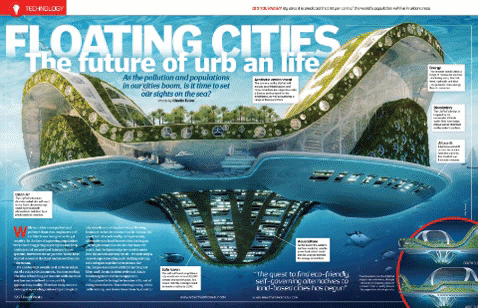Exclusive extract: floating cities
Enjoy your exclusive sneak peek at the latest edition of How It Works…
Floating cities: the future of urban life
As the pollution and populations in our cities boom, is it time to set our sights on the sea?
With our cities more packed and polluted than ever, engineers and architects are being forced to get creative. In the face of a growing population we’ve built staggering skyscrapers and deep underground networks of transportation systems, but where do we go next? Some have started to look at the final unclaimed frontier – the ocean.
It’s an idea that sounds as if it’s been taken out of a science fiction movie, but seasteading (the idea of building permanent settlements at sea) has materialised into a quickly approaching reality. Whether designers are looking at up-scaling cruise ships into giant city vessels or crafting individual floating homes attached to one another in the sea, the quest to find eco-friendly, self-governing alternatives to land-based cities has begun.
It might sound like an idea far from our reach, but the knowledge we need to move into the oceans already exists – it’s now only a case of experimenting and trialling existing technologies together to overcome the challenges associated with life in the great blue, and the motivation to do just that is becoming more and more apparent.
Our planet is facing the imminent threat of rising water levels. Since the beginning of the 20th century, sea levels have risen by about 20 centimetres, and it is predicted that the oceans will rise by around 65 centimetres by 2100. Scientists estimate that 275 million people worldwide are currently living in areas that will be submerged if the global temperature rises by three degrees Celsius. If global warming continues, the famous beaches of Rio de Janeiro in Brazil will soon be underwater; Shanghai in China, with its population of over 24 million people, will be completely destroyed; and Miami in the US will see more than just knee-deep water flooding the town. Without a solution, this will cause large-scale devastation and loss of life, with millions of people’s homes and livelihoods being destroyed. This has inspired companies to begin forming plans to build cities out at sea to ensure we stay high and dry.
Extract from Floating cities by Charlie Evans. Featured in How It Works 110.
To read the full article, pick up a copy of issue 110 today. How It Works is available from all good newsagents, at My Favourite Magazines, or via the How It Works app on the App Store or Google Play.






